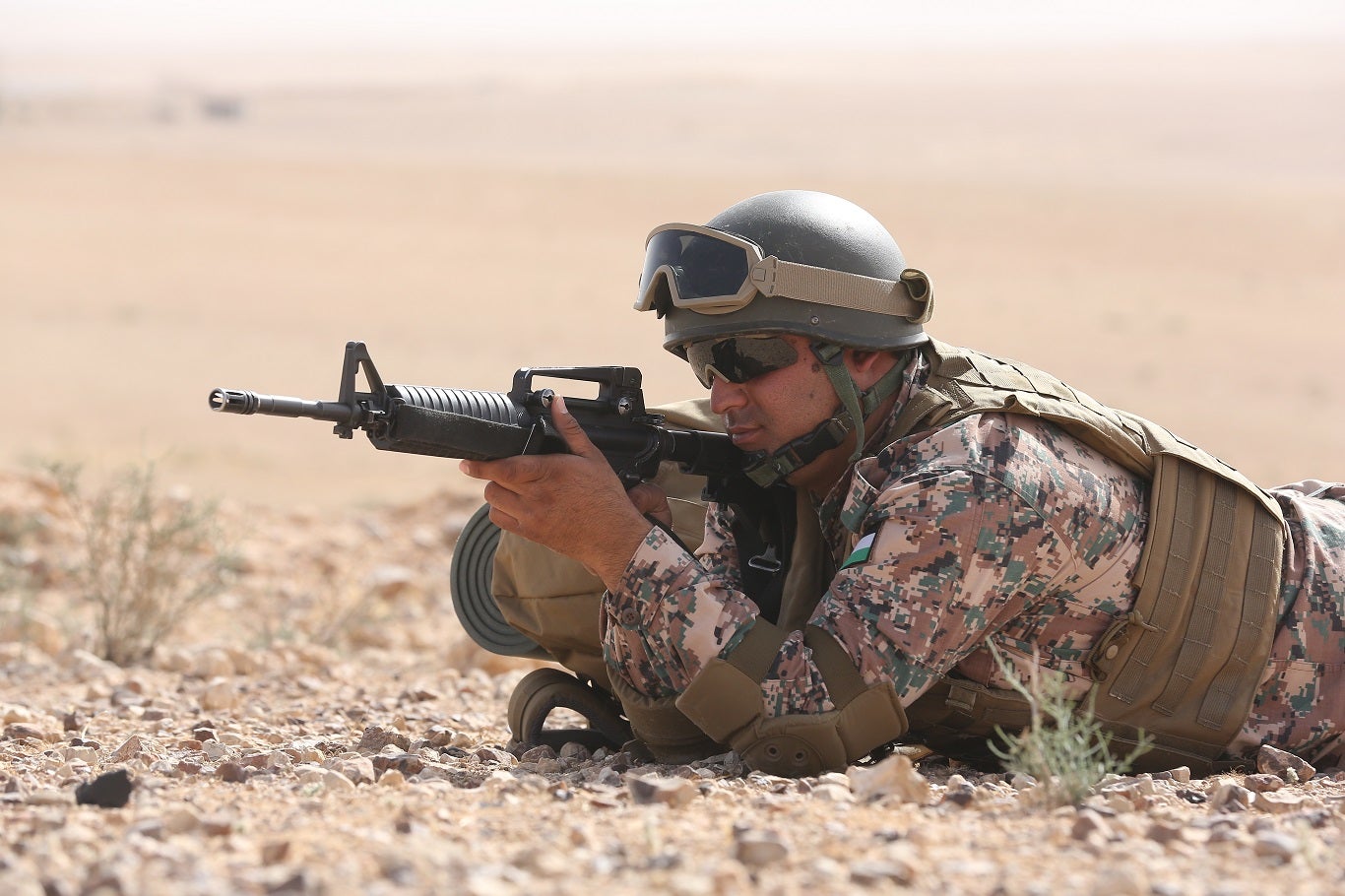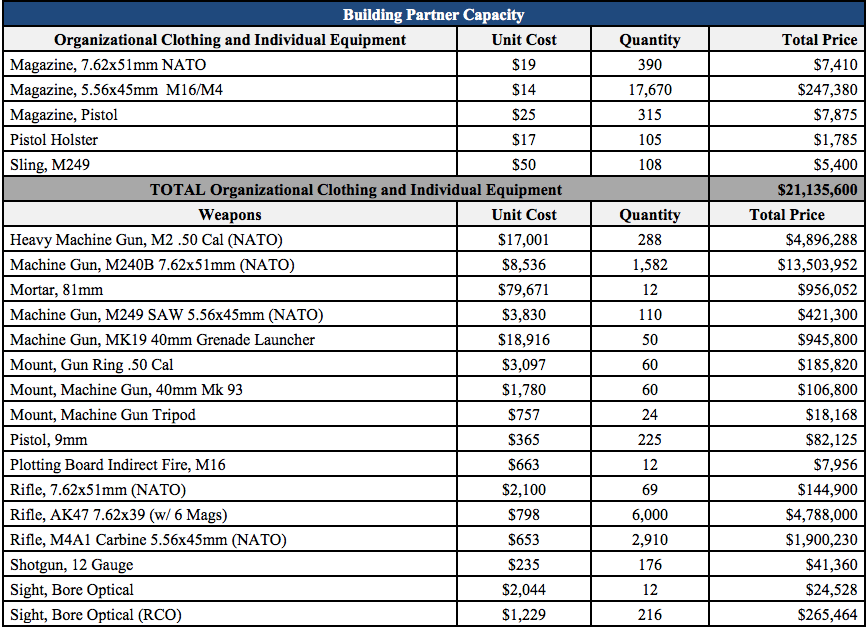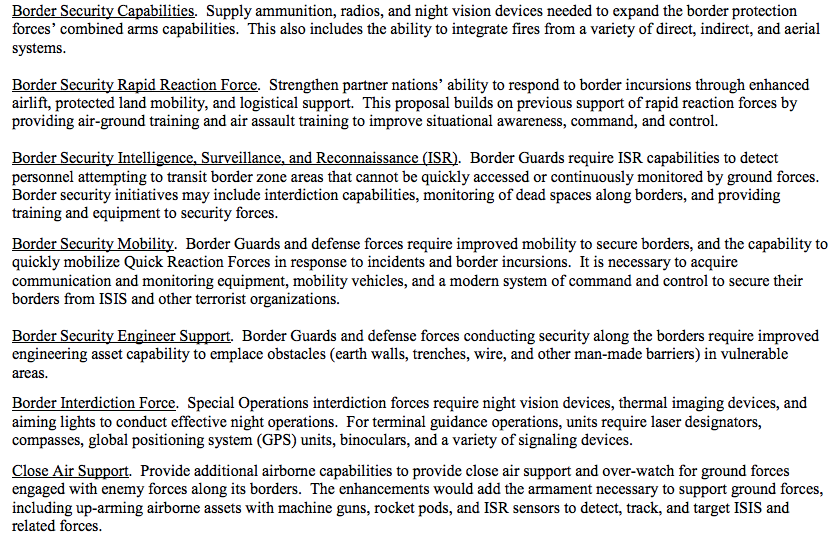The Fiscal Year 2019 Department of Defense Budget Proposal has been submitted to Congress and will take some time before we find out if it is approved or denied. But within it there is a specific budget document titled “Counter-Islamic State of Iraq and Syria (ISIS) Train and Equip Fund (CTEF)”. This proposal covers the Pentagon’s plans to purchase equipment and arms that will be provided to forces that the United States (i.e- SOCOM) supports in Syria and Iraqi government security forces. At the low end of the supply chain are items such as magazine pouches and canteens, while at the high end are HUMVEEs and bulldozers. We are going to narrow down our focus to the small arms segment for TFB’s interests. A key element to keep in mind here is that this proposal hasn’t been approved yet and thus we are simply looking at what the Pentagon wants, instead of what they are going to get in terms of funding for all this equipment. The final result could be less, or it could even be more depending on the politics that go into the decision making process.
First on the proposal is the assistance to Iraqi forces, in particular, the ISOF (Iraqi Special Operations Forces) and the ERU (Emergency Response Unit) units that fall under the CTS (Counter Terrorism Services). Both of these units are a part of the Iraqi Ministry of the Interior, which is completely separate from the Iraqi Armed Forces. ISOF has made quite the name for itself in really being the spearhead of the offensive against the so-called Islamic State. When the Iraqi Army was in full retreat in 2015, ISOF was one of the few forces that actually held together in fighting a delaying action against the insurgent force. Unfortunately, this was actually beyond the scope of the small force. The original intent of ISOF was to be a strictly internal counter-terror force within Iraq, not the fully fledged mobile infantry unit that it has morphed into by necessity over the course of the war. The proposal makes a point in saying that ISOF has to now return to the group’s original roots in internal security operations. Likewise, the ERU units were originally intended to only respond to internal terrorist attacks, but as the war dragged on and ISOF started taking heavy casualties, ERU stepped up to fill the slack. Again, this was in a role that it was never designed to accomplish as a direct action mission.
Other forces mentioned are Border Patrol units, Energy Police for infrastructure security, and a new force called the Qwat Khasah(القوات الخاصة- Special Forces). This force is intended to be that sort of frontline direct action that ISOF inadvertently fallen into during the fight against the insurgency.
From the tables below, it would appear that the majority of the U.S. equipment might be going to the Qwat Khasah battalions due to the large number of M4A1s present. It appears that these will be mounted with either EoTech or Aimpoint optics in addition to a few Trijicon RCOs. The AKMs that are listed would appear to be going to those Border Patrol and Energy Police elements. ERU is universally armed with the 5.56x45mm NATO VHS-2 rifles from Croatia and ISOF is armed with M4A1s of either Rock Island or Colt manufacture. As evidenced in the video above, it appears that the Qwat Khasah companies are using K2C rifles from Korean S&T Motiv (a large number of which were previously seen with ISOF). This proposal might reflect a complete rearming of that force with M4A1s.
Also notice the 7.62x51mm NATO magazines and the 7.62x51mm NATO rifles on the list. This probably indicates M14 EBRs for the Qwat Khasah force as a DM rifle. Previous use of the M14 EBR was seen with ISOF forces. From interviews with ISOF operators, these rifles are apparently the least accurate of their sniper systems, the others being Remington M24s and Osiris T-5000s.
Next on the proposal list are the small arms requirements in Syria. The majority of this appears to be going directly to the Kurdish forces that have taken over vast parts of the previously insurgent-controlled territory. Specifically, this would be the Syrian Defense Force, or SDF, which is a mostly Kurdish force but also has elements from other ethnic groups that are contributing to it. Of particular note here is the fact that some sources are saying that the Kurds are getting double the amount of AKMs than from last years supply. This year the AKM allotment is up to 25,000 rifles in total.
An interesting observation is that although the proposal calls for only 95 SVD (misspelled as SDV) designated marksman rifles, it is also calling for 1,000,000 rounds of 7.62x54mmR. This is most likely to support existing stocks of SVDs instead of the current 95 that will be going to arm the Kurds. Not on this list is any sort of anti-materiel rifle, which are becoming very necessary for defeating SVBIED attacks. This might be due to the decrease of such attacks now that the so-called Islamic State has mostly fallen within Syria (compared to previous years). Note that there are large amounts of mortars and associated rounds, especially 120mm varieties. This is probably due to the Kurdish forces taking a more defensive posture in dug in positions instead of being on the offensive.
Although probably not in time to fill these requirements, SOCOM released an earlier solicitation for U.S. companies to produce American made PKMs, NSVs, and DShKs. The reason for this is to get a quality machine gun in the hands of these partner forces that is far superior to the Cold War era small arms that they are otherwise being armed with.

A members of the Jordanian Armed Forces provides security during Exercise Eager Lion 16 at Armor Range, Quick Reaction Force, Kingdom of Jordan on May 16, 2016. Eager Lion 16 is a bi-lateral exercise in the Hashemite Kingdom of Jordan between the Jordanian Armed Forces and the U.S. Military designed to strengthen relationships and interoperability between partner nations. (U.S. Marine Corps photo by Lance Cpl. Alejandro Dominguez/Released)
The final portion of the proposal is devoted to “Border Security for Areas Outside of Iraq and Syria”, which is calling for $250,000,000 of equipment but doesn’t list any specific tables of equipment requirements. Although it doesn’t list any country, my honest guess is that the majority of this aid will be going to the Jordanian border forces due to the proximity of Jordan to volatile portions of Syria. The United States already supplies Jordan with a tremendous amount of military aid to the countries strategic position. Other countries that border Iraq and Syria are Saudi Arabia (Iraq), Lebanon (Syria), and Turkey (Iraq and Syria). Saudi Arabia typically has a large internal budget for such defense matters and Turkey has so much control of its Syrian border that is launching military operations within Syria. Lebanon is perhaps a close second due to the majority of the country bordering with Syria. Kuwait also borders Iraq, so Kuwait could possibly be a recipient of this aid as well.
Primary Source:
United States, Congress, COUNTER-ISIS TRAIN AND EQUIP FUND. “Justification for FY 2019 Overseas Contingency Operations (OCO).” Justification for FY 2019 Overseas Contingency Operations (OCO), Under Secretary of Defense (Comptroller), 15 Feb. 2018. comptroller.defense.gov/Portals/45/Documents/defbudget/fy2019/fy2019_CTEF_JBook_Final.pdf.
 Your Privacy Choices
Your Privacy Choices






